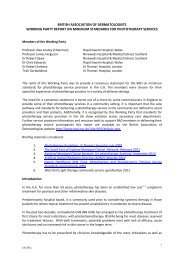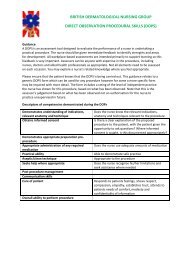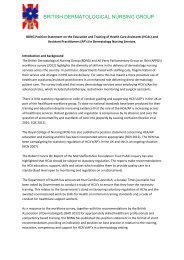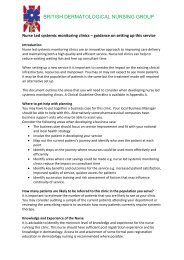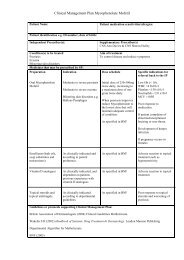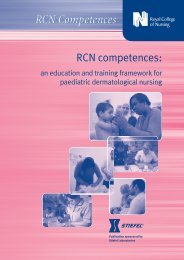Improving outcomes for people with skin tumours including melanoma
Improving outcomes for people with skin tumours including melanoma
Improving outcomes for people with skin tumours including melanoma
Create successful ePaper yourself
Turn your PDF publications into a flip-book with our unique Google optimized e-Paper software.
<strong>Improving</strong> Outcomes <strong>for</strong><br />
People <strong>with</strong> Skin Tumours<br />
<strong>including</strong> Melanoma<br />
Organisation of <strong>skin</strong><br />
cancer services<br />
Commissioning arrangements should be made by the cancer network<br />
<strong>for</strong> the funding of histopathology reviews from the LSMDT to the<br />
SSMDT, and by the cancer network <strong>for</strong> funding supranetwork<br />
pathology referrals from the SSMDT <strong>for</strong> tertiary opinions in difficult<br />
diagnostic cases.<br />
Organisation of LSMDT and SSMDT meetings<br />
The core LSMDT and SSMDT should meet at least every 2 weeks. The<br />
MDT should assume responsibility <strong>for</strong> all cases of <strong>skin</strong> cancer referred<br />
to them. All team members should attend the majority of meetings<br />
and should participate in collaborative decision-making, although<br />
different criteria apply to GPwSIs. At least once a year the LSMDT and<br />
SSMDT extended teams should meet <strong>with</strong> their core teams to discuss<br />
team and organisational issues <strong>with</strong> a designated trust manager.<br />
3<br />
Decisions about management and standards <strong>for</strong> therapy should follow<br />
documented clinical protocols that have been agreed throughout the<br />
network. These protocols should be demonstrably evidence-based<br />
and should be produced jointly by members of all the teams in the<br />
network that deal <strong>with</strong> <strong>skin</strong> cancer. Patients who fit the criteria <strong>for</strong><br />
inclusion should be asked if they would like to participate in NCRNand<br />
WCTN- recommended clinical trials.<br />
Medical photography has an important role in the recording of clinical<br />
images <strong>for</strong> <strong>skin</strong> lesions and should be used where appropriate to aid<br />
decision-making at MDT meetings.<br />
One member of the LSMDT/SSMDT (usually the lead clinician) should<br />
take managerial responsibility <strong>for</strong> the service as a whole. Audit of<br />
process and <strong>outcomes</strong>, and actions arising from audit results, should<br />
be discussed in team meetings (Table 3). Data collection systems<br />
should be compatible across pathology departments and all <strong>skin</strong><br />
cancer teams to facilitate network-wide audit.<br />
Meetings should be arranged by the team secretary/coordinator, who<br />
should ensure that in<strong>for</strong>mation necessary <strong>for</strong> effective team<br />
functioning is available at each meeting. This will include a list of<br />
patients to discuss and copies of their case notes, along <strong>with</strong><br />
diagnostic staging and pathology in<strong>for</strong>mation.<br />
Preparation and attendance at meetings should be recognised as a<br />
clinical commitment, and time should be allocated accordingly and<br />
reflected in consultant job plans. Team members should be<br />
adequately prepared <strong>for</strong> each meeting, so that cases can be discussed<br />
<strong>with</strong>out delay. The team should elect a lead clinician who takes<br />
managerial responsibility and represents the team on the <strong>skin</strong> cancer<br />
network site-specific group.<br />
62<br />
National Institute <strong>for</strong> Health and Clinical Excellence




